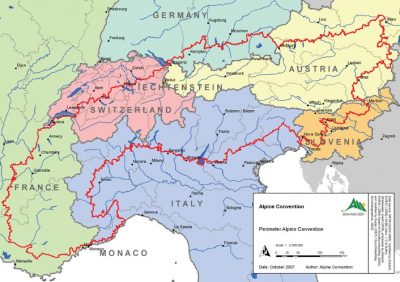The Alpine Convention
PDF
The International Treaty for the Sustainable Development and Protection of the Alps, known as the “Alpine Convention”, was signed on 7 November 1991 in Salzburg (Figure 1).
The Framework Convention entered into force in 1995 after being ratified by the Alpine countries concerned (Austria, France, Germany, Italy, Liechtenstein, Monaco, Slovenia, Switzerland and Austria) and the European Union (Figure 2).
It was followed by the signing of eight more operational protocols (landscapes, forests, soils, etc.)[1].
This is an international commitment of France, duly ratified and therefore in theory opposable to administrative acts. However, for the time being, French law does not consider this convention as one of its major sources of inspiration: rarely taken into account by public authorities, its stipulations are deemed not to be all directly applicable because of its too general wording. However, although few in number, provisions are likely to apply directly to the competent land use authorities[2]. For example, this is the case with Article 11, paragraph 1 of the Transport Protocol, which stipulates that “The Contracting Parties shall refrain from building new high-speed roads for transalpine traffic”.

References and notes
[1] For a complete list of protocols to the Alpine Convention: http://www.alpconv.org.
[2] YOLKA, Ph. D., dir. The Alpine Convention, a new right for the mountains? , CDM, CIPRA, 2008.
[3] http://www.carpathianconvention.org and DUTU, M., The Protocol on the Conservation and Sustainable Use of Biodiversity of the Carpathians, RJE 3/2011, p. 305.




